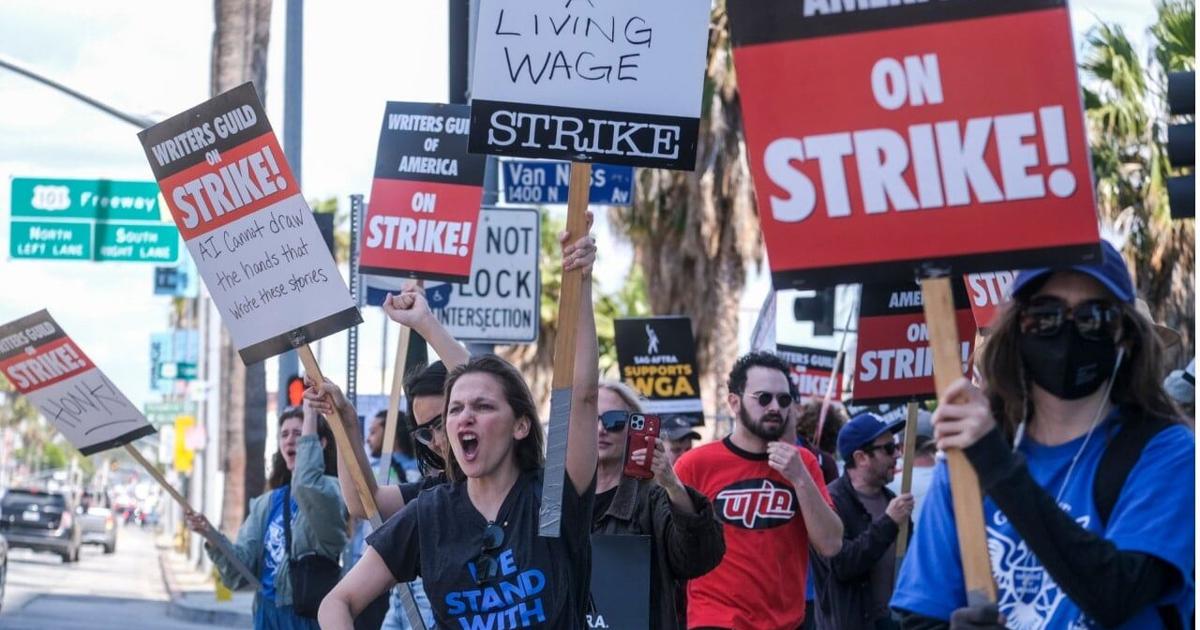The ongoing strikes by the Writers Guild of America (WGA) and Screen Actors Guild – American Federation of Television and Radio Artists (SAG-AFTRA) have now passed significant milestones.
The WGA strike began on May 2nd, hit 100 days on August 9th, and is about two weeks away from becoming the longest writer’s strike in Hollywood’s 100-year history. The Actors have been officially striking since July 14, just a little over two months. It’s been 63 years since the two powerful Guilds have joined each other in a picket line.
Hollywood studios are negotiating – or rather not negotiating – with the actors and writers via their combined bargaining organization, the Alliance of Motion Picture and Television Producers (AMPTP).
The business of Hollywood has essentially ground to a halt. The devastating impact of the dual strikes cannot be overstated for an industry that contributes billions of dollars to the economy annually.
Local Economies in Jeopardy
As the capital of the Hollywood machine, California is the first to feel the heat. Amid the maelstrom, California-based writers and actors, without the means to withstand months of no income, have started feeling the financial strain, turning to side hustles like dog-walking, babysitting, or Uber Eats jobs to pay the bills.
This double strike doesn’t just affect the entertainment industry, however.
Local businesses rely on film and TV productions to make ends meet. With production stoppages all over town, catering services, grocery stores, and event planners, who typically handle promotional events for the studios, lose their usual income stream. It is estimated that roughly 700,000 jobs in California have been directly or indirectly impacted by the strikes.
To offset some financial difficulties, Hollywood A-listers like Oprah Winfrey, Leonardo DiCaprio, and The Rock have gathered funds to support their struggling cohorts. Meanwhile, thousands of non-stars have stepped up to offer financial support as well.
The effects are not only felt in Los Angeles and the state of California but have reverberated across the US and beyond. Delayed filmings have begun impacting other states besides California and New York.
In Montana, home to shows like Paramount+’s 1923, work stoppages mean ancillary suppliers like set builders, lumber companies, and horse wranglers are left jobless.
In Georgia, where TV and film productions brought in $4.4 billion to the economy last year, the repercussions of work stoppages trickled down to secondary industries: hospitality sectors like hotels and restaurants, transportation service, hair and makeup, dry cleaners, and so on.
The US economy won’t be the only one suffering. The United Kingdom, Australia, New Zealand, and other countries that either have studios or do post-production for them are also feeling the pinch.
Still, those affected reiterate their belief that the strikes are necessary for the future of their industry. Here are some of the biggest, most critical demands laid out by WGA and SAG-AFTRA that AMPTP refused to give ground on leading up to the present situation:
- Better residuals and detailed viewer numbers from streaming services. Streaming services did not exist when they negotiated their last deal in 2008. With its global reach and new model, the streaming economy has enriched the studios but not the writers and actors who create the art they exploit.
- The impact of the streaming model, first introduced by Netflix, has impacted in other ways as well, leading to shorter TV seasons, making it difficult for the majority of the 170,000 actors and writers who aren’t superstars to earn a middle-class living.
- Artificial Intelligence (AI). Arguably the most critical talking point in both negotiations, WGA and SAG-AFTRA demand fair regulations on the use of AI in scriptwriting or replicating an actor’s likeness.
No Clear End in Sight
So far, the studio’s representatives, the AMPTP, have yet to find middle ground – or even attempt to engage with the SAG-AFTRA and WGA in recent weeks. Both the WGA and SAG-AFTRA have repeatedly offered to come back to the table as soon as the studios are willing to negotiate.
With neither the studios nor their representatives willing to talk, the two guilds and their leadership have taken to social media, as well as engaging in rallies and impassioned speeches, like recently re-elected SAG President Fran Drescher, who lambasted the major studios for claiming “that they’re losing money left and right when giving hundreds of millions of dollars to their CEOs.”
Several high-profile films have already had their release dates pushed back, in part because strike rules do not permit stars to promote their movies or walk red carpets.
This will significantly affect theater owners and dampen an industry still recovering from the devastating impact of the pandemic.
Both guilds have made it clear that the strikes need to end concurrently to resolve the issue. No one wants the strikes to continue but believe they are necessary. Unity is higher than it’s ever been, and even if one strike is resolved, the other must conclude for production to resume.
Recent polls from Gallup confirm that most of America supports the creatives on strike, and in fact, their solidarity has inspired others in and out of Hollywood to stand up for fair wages for themselves as well.
Seeing as how the writers and actors are fighting for their survival as well as that of the entertainment industry itself, the picket lines will likely remain for the foreseeable future.
This article was produced by Media Decision and syndicated by Wealth of Geeks.




